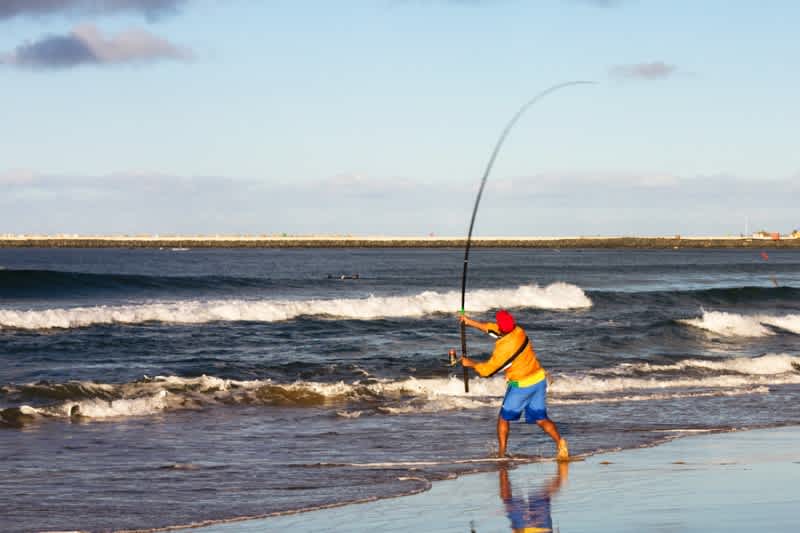Ten Tips for Successful Surf Fishing
Laurie Lee Dovey 08.12.14

With the final days of summer upon us and fall right around the corner, looking to the surf for some great fishing action should be on every outdoor enthusiast’s list. Great opportunities to catch both numbers of fish and numbers of species abound. Salty seas, still-warm waters, and diminished crowds also await—so it’s a great time for a family outing, too.
When I think of surf fishing, my friend Angleo Peluso immediately comes to mind. He’s a fly and surf fishing expert and author of the book Fly Fishing The Surf. I turned to Angelo for some advice on successful surf fishing whether you’re traveling to the beaches of Maine, the Sunshine State, or anywhere in between.
1. Plan carefully.
Consistently successful surf anglers plan each outing and where they will fish, rather than leave the day’s results to happenstance. Many factors go into preparing a fishing plan, and most of those elements come with experience and acquired knowledge from time on the water. If you’re new to an area, don’t ignore local knowledge. Talk to bait and tackle shop owners and local anglers.
2. Learn to read water and gain a thorough understanding of the environment within the surf zone.
Especially focus on the behavioral patterns and interactions of predators and prey. Visualize what is going on beneath the water.
3. Get out during prime time.
Regardless of where you fish along the East Coast, there are three universally accepted prime times for fishing the surf: pre-dawn into the early morning hours, the time period immediately before and after dusk, and during the dark hours of the night. Fishing at these times often offers some of the best fishing windows.
 4. Understand the seasons.
4. Understand the seasons.
No matter where you fish along the East Coast, the spring and fall months are prime periods for the surf angler. Most gamefish exhibit heightened activity at these times, whether it’s the result of pre- or post-spawning activity or the abundance of baitfish and ideal water conditions. The hotter summer months can either be boom or bust depending on where the fishing occurs. But shoulder-season anglers will experience the most intensely concentrated fishing of the year—and winter fishing in the Southeast and throughout the Gulf Coast can be spectacular.
5. Consider the moon phases.
Much has been written about the best moon phases for fishing the surf. In the final analysis, new moon and full moon phases both have their advocates. Some anglers fish religiously for two or three days on either side of a new moon, while others will totally ignore the new moon and concentrate all their efforts around the big tides of a full moon. A chat with local anglers might give you an indication of if or how they feel the moon affects fishing.
6. Pay close attention to the tides.
An understanding of tides and currents and their interrelationship is one of the most important factors for successful surf fishing. In many respects, they are mutually dependent. Both forms of water flow influence movements and feeding behaviors of baitfish and gamefish. Fish will transition deeper into inter-tidal areas on the flood and follow bait with retreating water. For example, striped bass will often move on and off flats with flooding and ebbing tides. Fish will also feed deeper into marshes, grass lines, mangroves, harbors, and backcountry areas on high water, and again move out with falling water. Game fish naturally gravitate toward areas of current where vulnerable prey can be ambushed.
7. Use wind to your advantage.
Wind is often viewed as the number-one nemesis of saltwater anglers, but it can be an ally. Winds coming off the water and onto the beach often push baitfish into the surf zone, where gamefish follow. While extreme winds certainly present challenging and often overwhelming casting conditions, moderate wind can be a surf angler’s friend.
 8. Consider tactical wading.
8. Consider tactical wading.
Some surf anglers prefer to stay put in one known productive spot while others are constantly on the move, opting to seek fish out rather than wait for the fish to come to them. However, the approach is not one of aimlessly walking but rather a strategy that embraces many of the elements previously discussed, including season and time of day, tide phase, current flow, and bait movements. How, where, and when you fish and wade should be determined through integration of that knowledge and projecting where the bite is most likely to occur.
9. Practice safety at all times.
Bad things can happen quickly on and around water. Pay attention to your surroundings. Shifting sands from storms can create new hazards, and jetties can be especially dangerous. Wade cautiously, rather than simply plodding ahead. While wading, take it slow. Shuffle your feet laterally as you move instead of taking big, blind steps. Careful, slow wading also means spooking fewer fish.
10. Be prepared and have fun.
There is nothing more frustrating than being on a beach or on some expansive sand flat only to realize you left a critical piece of angling gear back in your vehicle, or at home. If you plan on spending an entire day on the water to take advantage of both tide cycles, pack extra gear and essentials in backpack or fanny pack. Also be sure to bring food and drinks. You don’t want hunger or thirst to hamper your efforts when the fishing turns on.
Author’s note: For more information on this topic, pick up Angelo’s best-selling book, Fly Fishing The Surf. It’s available at all major book stores and online, or direct from the author at APdotcominfo@aol.com. Angelo’s other books include Saltwater Flies of the Northeast, Fly Fishing Long Island, and Saltwater Flies of the Southeast and Gulf Coast. His first novel, a work of science fiction, will be released by Skyhorse Publishing in November 2014. It has a very fishy plot.




